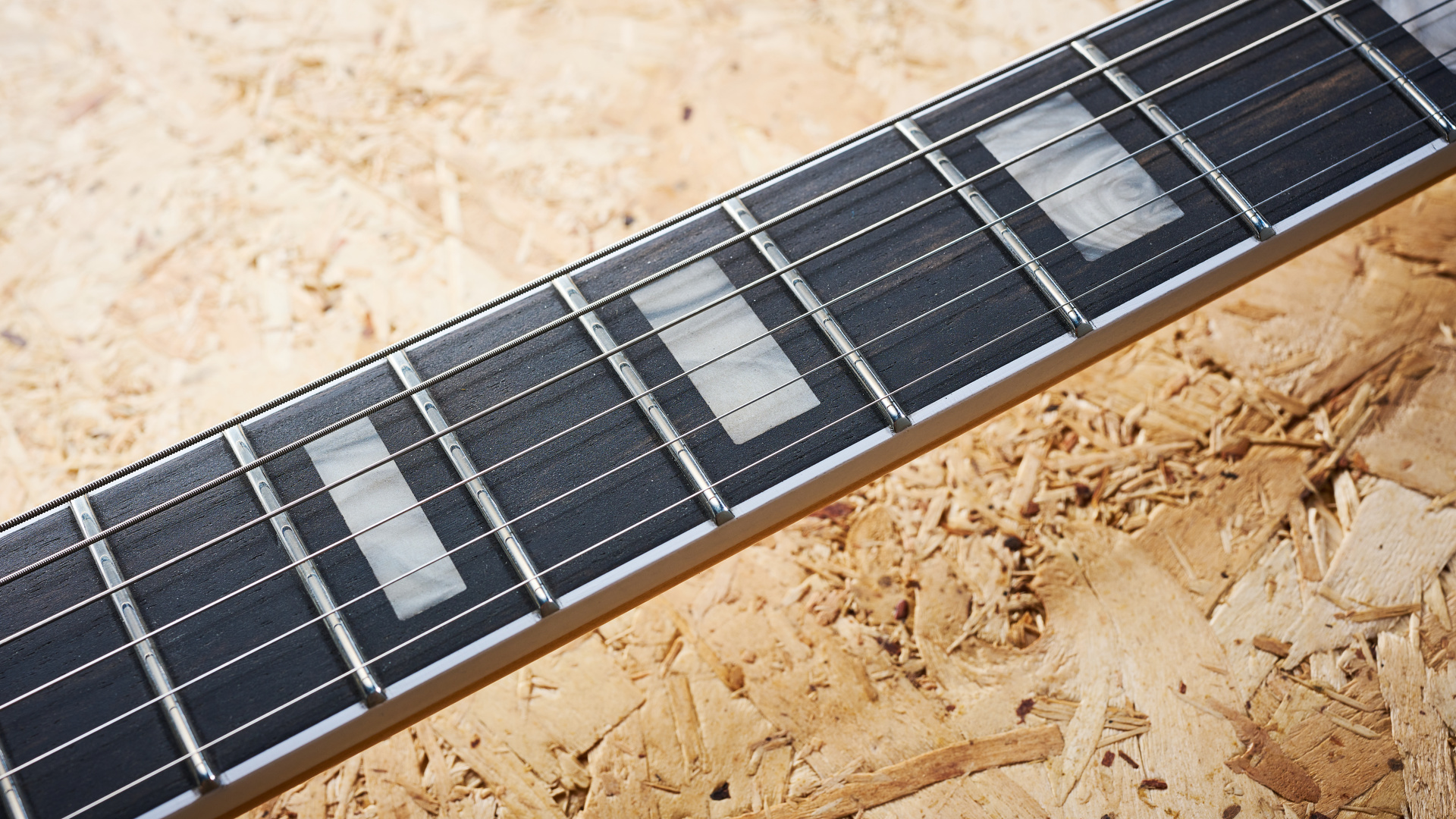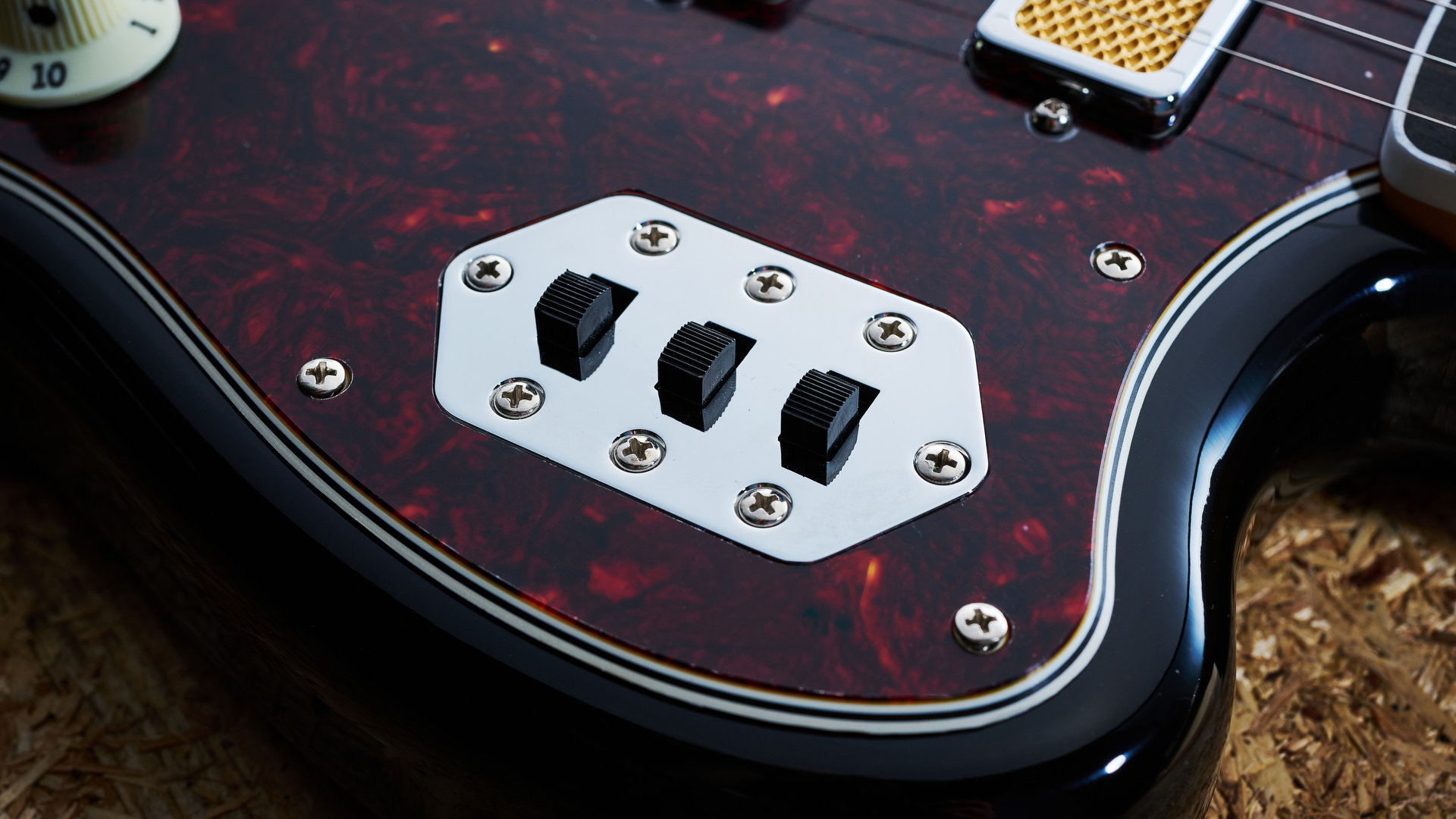MusicRadar Verdict
Pros
- +
Mini-humbuckers offer a great combination of tones here
- +
A fresh, cool-looking take on the Jazzmaster blueprint
Cons
- -
The pickups are not 'authentic' gold foils, despite the name
- -
Truss rod nut adjustment requires the neck to be removed
- -
Our test guitar had tuning issues
MusicRadar's got your back
Fender Gold Foil Jazzmaster: What is it?

What is called Gold Foil, has gold foils but isn't actually a gold foil? It's the Fender Gold Foil Jazzmaster.
While traditional gold foil pickups feature gold foil, it's purely cosmetic and not the feature that defines their sonic character. DeArmond and Teisco were the two frontrunners to showcase them in the 1950s, and despite a lot of variations over the years from different makers, they're defined by a rubberized ferrite magnet – the kind of magnet you'd find on a fridge. They were a weaker, cheaper magnet than the kind found in the Fenders and Gibson of the time, but they had their own perks.
The ferrite magnets tended to be longer, allowing more balance between strings and richer harmonics, despite the lower output. The pickups in Fender's Gold Foil Collection don't use ferrite magnets and are not traditional gold foils, they're mini-humbuckers.
Fender comes clean about this in the spec, but calling this a Gold Foil guitar in its model name is odd and confusing all the same. A Jazzmaster with three mini humbuckers is still enough of an event without a deceptive moniker to sow any sourness or confusion. And the pickups are only part of what this unique Fender is bringing to the table here.

There's a Bigsby Tremolo, the body is mahogany and the ebony fretboard is bound. The headstock is painted and with the Candy Apple Burst finish here (the other option is Shoreline Gold) it is very Teisco-esque, even without the gold foil authenticity. Even the machine heads are plastic for some lo-fi aesthetic (though without the lo-fi price). We could imagine pawnshop guitar connoisseur Dan Auerbach raising an approving eyebrow in its direction.
There's no pickup selector in sight either; it's all on those three black Jaguar-style switches. Plenty of talking points here, for sure!

Fender Gold Foil Jazzmaster: Performance and verdict
At 9.4lbs this is the heaviest Fender guitar your humble reviewer can remember encountering; it's pretty hefty even by contemporary Les Paul expectations. The Gold Foil Jazzmaster certainly makes its mahogany, Bigsby and trio of mini-buckers count.
Both UK retailer Peach and US giant Sweewater display the weights of most guitars they have in stock so we can get a little perspective from a browse on their sites; as the time of writing Sweetwater's heaviest example of this exact model is 9lbs 15 oz, while the lightest is 8lbs 5oz. The Shoreline Gold models were mostly coming in under 9lbs, but not by much. So be prepared for heft with this model.

Where's the truss rod nut? It's at the butt of the neck – vintage style
This is up there with the pricier Mexican models that the Player Plus series heralded, and while we don't get the lovely rolled fingerboard edges of those guitars with this kind of binding, we do get a welcoming medium-low action and springy tension out of the box. The ebony-bound neck looks as great as it feels too – with a satin back. But we soon spy a less appealing feature.
Where's the truss rod nut? It's at the butt of the neck – vintage style. So any adjustments and you'll have to take the neck off, at least partly. Who would possibly want this added hassle in 2023 in a reality where truss rod adjustment is a necessity for a guitarist? If Fender is going for a vintage vibe here, it's not necessary on a guitar that isn't an authentic reproduction of something that has gone before.

While we're having a moan about questionable decisions, the 'Deluxe' gig bag included with this guitar is the same one you get with a – significantly cheaper – Player series electric guitar model. It's pretty basic and is actually a snug fit for this model in terms of height. Too snug. I think it needs an update on higher-priced Mexican models like this because it doesn't offer the level of fabric quality or thickness protection that buyers get with the Acoustasonic Player models' included FE1225 gig bag. And those Mexican-made guitars cost less than this.

But let's move on to the real questions here; how does it sound and play? Mini humbuckers are sometimes confused with traditional Firebird pickups because of the similar look, but they're structurally different. Neither are like traditional humbuckers and are physically smaller (the mini humbucker is P-90 sized). Both were invented by Gibson.
Firebird pickups use two magnets in a rail formation while mini humbuckers use a single bar magnet. While the Firebird rail magnets don't need steel posts because they pickup up the string vibrations, the mini-humbucker magnet touches each set of posts to create an opposing magnetic field in each set.

In character, the Firebird is a brighter, humless single-coil sound, and the bridge pickup can be pretty brash and metallic. The mini-humbucker is smoother in comparison but still bright and articulate compared to many full-size humbuckers.
This expectation certainly bears out in a direct comparison with a Player Series Mustang we have fitted with Sunbear P-90-size Firebird pickups (yes we're odd like that) and this Jazzmaster. Both share this strong sense of more defined string separation that we don't get with most humbuckers.
The extremes between the positions are less dramatic certainly, especially as have three in the Jazzmaster. What they aren't is muddy, even in the neck position. And the switch setup here also allows for some additional combinations; each switch turns a pickup on or off.

The choice tones come with the combinations; the neck and bridge pickups together add presence and depth to the latter's chime for a satisfying balance
The neck can get pretty jazzy on its own when you wind the tone control down, while the middle feels good for bitier blues and rock. But It's great for moody single-note parts with a generous drip of spring reverb, tremolo, and the Bigsby as the expressive cherry on the cake. But it comes with some indigestion.
Some will tell you Bigsbys are a nightmare for tuning stability, others will swear they're rock solid. The truth, unsurprisingly, is it's completely dependent on the individual guitar and fitting. The B50 here seemed to consistently unleash gremlins on the guitarist's old nemesis; the G-string. Nut and bridge lubrication, nut replacement, or fitting roller bridges can help. This being a review guitar, we had to go with the first option.
We tried using Music Nomad's Tune-It on the nut slot and the bridge saddle contact point (Mustang saddles are used here and have been a traditionally popular Jazzmaster mod for greater stability). Unfortunately, it didn't help with the tuning issue, suggesting this is something that may need further investigation from a tech. Frustrating.

Back to the pickups and the neck and middle bring a touch of hollow chime that might be our choice for more sensitive chord work with space to breathe, while the middle and the bridge mini humbuckers together sound quite Stratty - not the kind of thing you'd be expecting from humbuckers! All three? Well, more is more, as Yngwie once said. It's a subtler change than you might think and good for full-bodied rhythm.
If you're used to a three or five-way selector – and most of us are – it's an abrupt transition to using switches only at first, and because old habits die hard, we didn't find it as physically intuitive to change positions quickly mid-song. While it's the rhythm/lead switch and its tone and volume controls on the upper bout of a Jazzmaster traditional are something you can choose not to engage with, here the switches are essential. But the payoff is a logical way to access a collection of tones we've not heard from Fender humbuckers before.
MusicRadar verdict: This is not the gold foil experience you may be expecting from the name, but this guitar represents a unique-sounding Jazzmaster, albeit with some caveats – especially for the asking price.
Fender Gold Foil Jazzmaster: Hands-on demos
Premier Guitar
Normans Rare Guitars
John McNicholas
Get Offset
Fender Gold Foil Jazzmaster: Specifications

- TYPE: Solid-body electric, made in Mexico
- BODY: Mahogany, gloss polyurethane finish
- NECK: Maple '60s C-shape, bolt-on
- SCALE: 25.5”
- FINGERBOARD: Ebony, 9.5" radius
- FRETS: 21, Narrow Tall
- ELECTRICS: 3 x Fender Gold Foil Mini-humbuckers
- CONTROLS: 3x pickup switches, 1x volume, 1x tone
- HARDWARE: Bigbsy B50 vibrato, Jazzmaster bridge with Mustang saddles, Vintage-style tuners with white buttons, aged white 'witch hat' control knobs
- WEIGHT: 9.4lbs / 4.2kg
- CASE: Gigbag
- FINISHES: Candy Apple Burst [as reviewed], Shoreline Gold
- CONTACT: Fender

Rob is the Reviews Editor for GuitarWorld.com and MusicRadar guitars, so spends most of his waking hours (and beyond) thinking about and trying the latest gear while making sure our reviews team is giving you thorough and honest tests of it. He's worked for guitar mags and sites as a writer and editor for nearly 20 years but still winces at the thought of restringing anything with a Floyd Rose.
“I used everything I knew about music”: How Green Day exceeded expectations with their most ambitious song
YouTube just added AI tools that makes musicians, library music and video editors redundant
“Every one of them said yes without hesitation": Hank Marvin and Roger Taylor have just remade a '60s classic for charity










